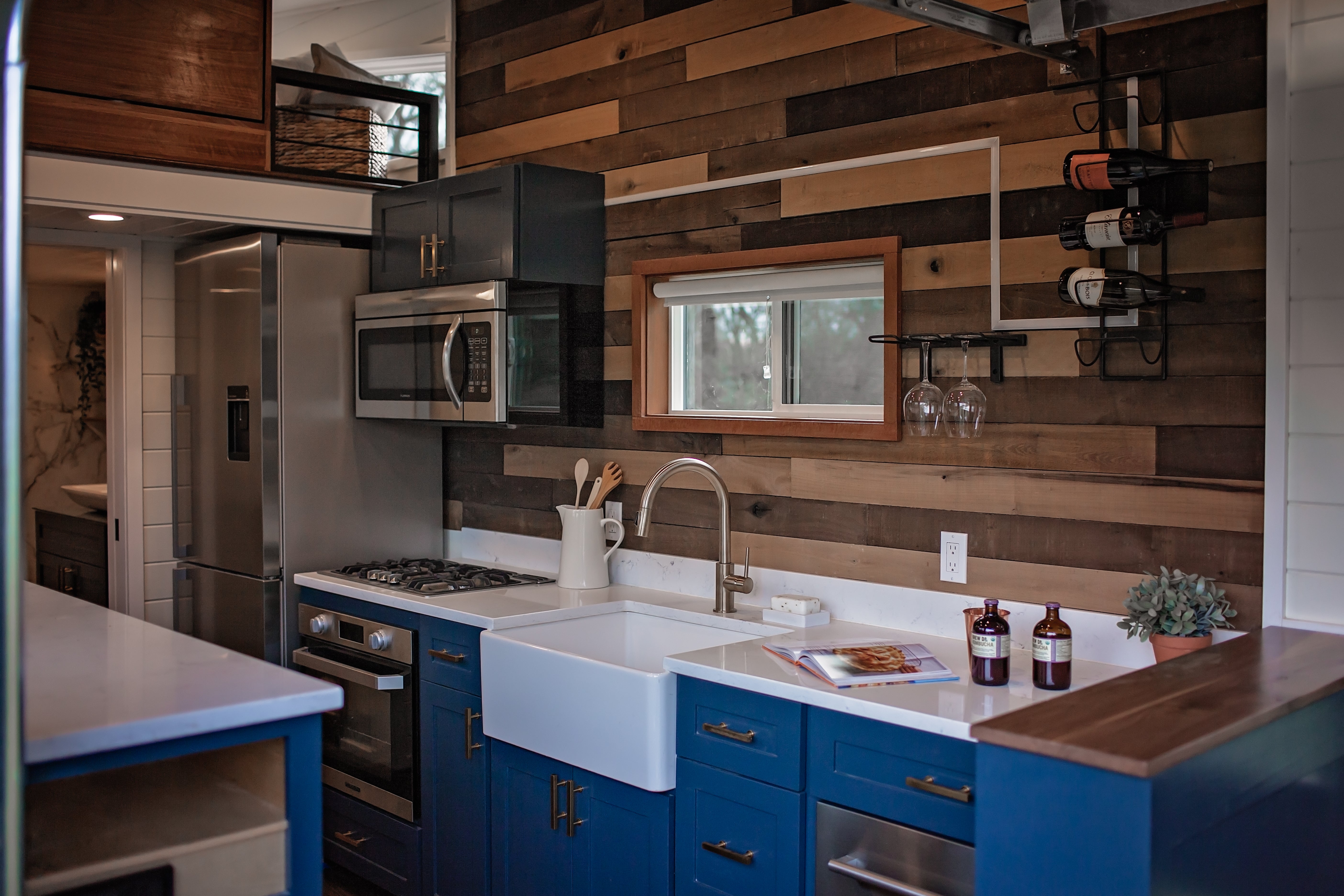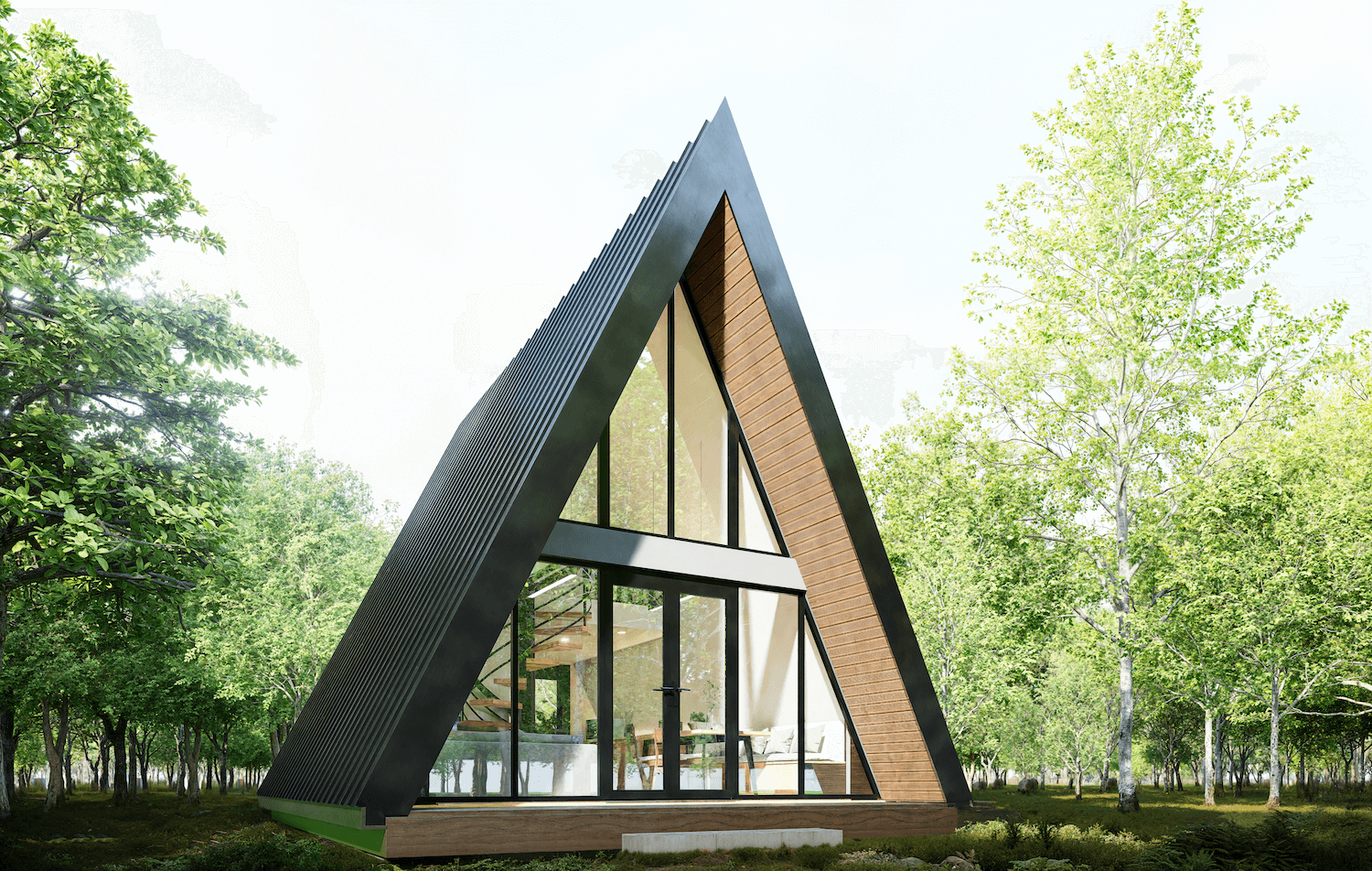Tiny homes are more than just a trend. They represent a shift toward affordable, sustainable, and intentional living. As more people embrace this lifestyle, every design choice becomes more important, especially the roof. Unlike traditional houses, tiny homes require roofing materials that are lightweight, durable, and space-efficient to keep the structure safe and functional.
That’s where many new builders hit a crossroads. Choosing the right roof isn’t just about aesthetics. It impacts energy efficiency, mobility, and long-term maintenance. The right material can help regulate indoor temperature with heat-reflective properties, support solar panels or green roof setups, and pair well with compact designs like shed, gable, or flat roofs. It can also simplify the construction process with low-maintenance, DIY-friendly options.
So, what roofing materials check all the boxes for tiny homes? Let’s take a look at the top lightweight options that offer both performance and peace of mind.
How to Choose the Right Lightweight Roofing for Your Tiny Home
Alright, let’s get real, choosing to roof for a tiny house isn’t just about what looks good in photos. Your roof is your armor, insulation, and climate shield, all rolled into one. With space at a premium, your roofing choice has to do more with less. So before you get sold on shiny metal panels or rustic shakes, here’s a breakdown of what actually matters.
Weight & Structural Load
Tiny homes, especially tiny homes on wheels, can’t handle the weight of traditional roofing. You need lightweight roofing materials like aluminum shingles or synthetic tiles that reduce strain on your structure and your trailer axle, if you’re mobile!
Durability & Lifespan
Let’s talk about values. Some materials might cost less upfront (like asphalt shingles), but metal roofing or rubber EPDM could last decades with low maintenance. Here's a quick glance:
|
Material |
Lifespan |
Weather Resistance |
DIY Friendly |
|
Metal Panels |
40–70 years |
Excellent |
Moderate |
|
Asphalt Shingles |
20–30 years |
Good |
High |
|
EPDM Rubber |
25–35 years |
Very Good |
Moderate |
Ease of Installation
Building it yourself? Go with DIY-friendly materials. Synthetic roofing or asphalt shingles are lightweight, easy to cut, and install with basic tools. Plus, they’re low-maintenance, so you won’t be on a ladder every month.
Energy Efficiency
Cool roofing materials, like white metal or rubber, reflect sunlight and help regulate indoor temperature, especially crucial in summer. Add in proper insulation under your roof deck to lock in comfort year-round.
Eco-Friendliness
Into sustainability? Look for recycled roofing materials or green roof systems. They’re stylish, functional, and kinder to the planet.
In short: Your roofing should be strong, smart, and light just like your tiny home.

The 6 Best Lightweight Roofing Material Options for Your Tiny House
Alright, let’s talk about tiny house roofing. You’ve got a cozy layout, clever storage, maybe even a composting toilet… but what’s covering your home? The roof isn’t just the cherry on top; it’s your weather shield, insulation layer, and part of your overall energy efficiency strategy.
And for a tiny home, you can’t just slap on a traditional roof and call it a day. You need something lightweight, durable, cost-effective, and ideally, DIY-friendly too.
Below are six of the best lightweight roofing materials, each with its own pros, quirks, and ideal use cases.
1. Metal Roofing (Aluminum or Steel Panels)
If you're aiming for a sleek, modern aesthetic and a roof that lasts for decades, metal roofing, especially aluminum or steel panels, is a top contender. These materials are known for their superior strength, resisting everything from high winds and rain to snow and even fire. Aluminum, in particular, is rust-resistant and extremely lightweight, making it a practical choice for mobile or stationary tiny homes. Metal roofs also reflect heat effectively, which means lower AC bills in hot climates. With minimal upkeep, they can last 40 to 70 years.
That said, the initial investment is usually higher compared to asphalt or synthetic options. And unless you install proper insulation underneath, you might hear every drop during a heavy downpour. For a cleaner aesthetic and enhanced waterproofing, standing seam metal panels are a solid upgrade.
2. Asphalt Shingles
A tried-and-true favorite, asphalt shingles are perfect for homeowners who want affordability, simplicity, and ease of installation. They come in various colors and styles to match nearly any exterior, and they're a great option for those with gable or shed roof designs. If you’re someone who enjoys hands-on weekend projects, asphalt shingles are DIY-friendly and easy to repair; just swap out the damaged pieces.
On the flip side, they tend to be heavier than other lightweight options and aren’t the best when it comes to eco-friendliness. Extreme heat can also shorten their lifespan if your attic isn’t well-ventilated. For a longer-lasting upgrade, opt for architectural asphalt shingles, which are more durable and offer better wind resistance than basic 3-tab styles.
3. Synthetic Roofing (Composite or Polymer-Based)
Synthetic roofing combines the beauty of natural materials like slate, cedar, or clay tiles with the practicality of modern technology. These roofing products are often crafted from rubber, plastic, or polymer blends and offer excellent durability without the weight or maintenance that comes with traditional materials. They’re highly fire- and impact-resistant, making them a smart choice for homes in remote or off-grid locations where longevity matters.
If you want that designer roof look without breaking the bank, synthetic options are a go-to. However, pricing can vary widely depending on the brand, and cheaper variants might fade with long-term UV exposure. A good tip for those in hot climates: choose a synthetic product with a cool roof coating to reflect more sunlight and lower your cooling costs.
4. Cedar Shakes
Cedar shake roofing offers a rustic, warm charm that’s hard to replicate. Made from real wood, these shingles look beautiful on cottages, log cabins, and tiny homes nestled in natural environments. When properly treated, cedar resists pests and decay, and its natural insulation helps keep homes cooler in summer and warmer in winter.
However, cedar requires regular maintenance; expect to reseal or treat it periodically to prevent weather damage. It’s not ideal for extremely wet areas unless you’re okay with moss or algae growth. Also, it won’t last as long as synthetic or metal roofing unless it’s well-cared for. To improve its longevity, install it on a steep gable roof so water drains quickly and the wood dries faster after rain.
5. Recycled Roofing Materials
For homeowners who prioritize sustainability and want a unique look, recycled roofing materials are a fantastic choice. These are often made from reclaimed rubber, plastics, or composite materials and are much lighter than conventional roofing while still offering solid weather resistance. Many of them are designed to mimic the look of traditional slate, tile, or wood without the cost or environmental impact.
Recycled materials are ideal for eco-conscious builders and those looking to qualify for green certifications. They're also a great conversation piece for modern tiny homes or urban designs. Just be aware that availability can vary depending on your location, and installation might require special fasteners or underlayments. Bonus tip: ask if the materials are recyclable again at the end of their lifespan; that’s a win-win for sustainability.
6. EPDM Rubber Roofing (Best for Flat or Low-Slope Roofs)
When it comes to flat or low-slope roofing, EPDM rubber is the go-to material. Originally designed for commercial use, it’s now a smart option for modern tiny homes with flat roofs, butterfly designs, or rooftop decks. It typically comes in large rolls, making installation quick and efficient. Once in place, EPDM requires little upkeep and can last 25 to 35 years.
The aesthetic, however, may not be for everyone. EPDM is usually black and utilitarian in appearance. And it’s not suitable for steep-sloped roofs. That said, you can improve its visual appeal and energy performance by topping it with a cool roof coating or decorative gravel. It’s especially handy for solar panels or green roofs where function outweighs form.

So… Which One Should You Choose?
Here’s the thing: there’s no one-size-fits-all answer. That’s the magic of building your own tiny home. Your roof should reflect your style, lifestyle, and location. Ask yourself:
-
Do I want to build it myself or hire a pro?
-
Will my home be mobile or stationary?
-
Am I in a climate with high heat, snow, or rain?
-
Do I want to invest more now for long-term savings?
If durability and efficiency are your top priorities, metal or synthetic options are your best bet. If you’re working with a tighter budget and prefer a more traditional look, asphalt shingles get the job done. And if you care about sustainability, recycled roofing materials make a great choice.
Still unsure? If you're planning to build in northern New Jersey, reaching out to a local specialist in Roofing Garfield NJ can help you make the right call. A pro who understands the area's weather patterns and building codes can guide you toward materials that are both practical and code-compliant.
Whatever your priorities, these six lightweight roofing options are all tiny house-approved, practical, stylish, and built for the long haul.

Roof Design Styles That Work Best with Lightweight Materials
Choosing the right roof design for your tiny home isn’t just about looks; it’s about making the most of your space, climate, and material choice. Some styles pair better with lightweight roofing materials, so let’s walk through a few that are both functional and stylish.
Gable Roof
The classic “triangle” shape. It’s one of the most DIY-friendly designs out there. Works great with asphalt shingles, metal panels, or even cedar shakes.
-
Pros: Excellent water drainage, space for lofts, looks great on cabins
-
Best for: Cold or rainy climates
Shed Roof
Simple, modern, and super efficient. It’s a single slope perfect for solar panels or installing EPDM rubber on a low-slope roof.
-
Pros: Easy to build, lots of natural light opportunities
-
Best for: Minimalist tiny homes, urban environments
Hip Roof
This one slopes on all four sides. It’s strong, wind-resistant, and pairs well with synthetic roofing materials or metal roofing.
-
Pros: Stability in high wind areas, great for mobile units
-
Best for: Tiny homes on wheels or areas with unpredictable weather
|
Roof Type |
Great With |
Bonus Features |
|
Gable |
Shingles, cedar, metal |
Adds attic/loft space |
|
Shed |
EPDM, metal |
Modern look, solar-ready |
|
Hip |
Synthetic, metal |
Wind-resistant, sleek design |
Whatever you choose, match your roof style with the right material, and your tiny home will look sharp and stay strong.
Cost & Installation Comparison Chart
Let’s be honest, budget matters. Especially when you're building a tiny house, every dollar counts. But roofing costs go beyond just buying the material. You’ve also got to think about installation, longevity, and even transport costs if you're in a remote area.
Here’s a quick breakdown of common lightweight roofing options, how much they’ll run you, and what you’re really getting:
|
Material |
Avg Cost/Sq Ft |
Installation Difficulty |
Lifespan |
|
Asphalt Shingles |
$1.00–$2.50 |
Easy |
20–30 years |
|
Metal Panels |
$3.00–$7.00 |
Medium |
40–70 years |
|
Synthetic Roofing |
$4.00–$6.00 |
Easy–Medium |
30–50 years |
|
Cedar Shakes |
$5.00–$8.00 |
Moderate |
20–25 years |
|
Recycled Materials |
$4.00–$7.00 |
Moderate |
25–40 years |
|
EPDM Rubber |
$1.50–$4.00 |
Easy |
25–35 years |
Pro Tip: If you’re going DIY, factor in tools, sealants, and extra underlayment; it adds up! But the right material can save you tons over time, especially if it's energy-efficient or low-maintenance.
Maintenance Tips for Lightweight Roofs
Just because your roof is lightweight doesn’t mean it should be low on your priority list. The secret to making your roof last 20, 30, even 50 years? A little TLC.
Here’s how to keep your tiny house roofing in top shape:
-
Inspect regularly, especially after storms or high winds
-
Clean debris from shingles, seams, and gutters to prevent water damage
-
Check seals and flashing on metal roofing and EPDM rubber.
-
Recoat synthetic or rubber materials every few years if needed
If you’re using cedar shakes, be ready for more hands-on care; they’ll need periodic treatment to prevent rot and insect damage.
For DIY-friendly roofing materials like asphalt shingles or synthetic options, having a basic repair kit on hand can save you time and money.
Pro Tip: Set a reminder every 6 months to do a quick rooftop walkaround. It’s 15 minutes that could save you years.

Conclusion
Choosing the right roofing material for your tiny home isn’t just another task on your to-do list; it’s a decision that influences how comfortable your home feels, how much energy you use, how long your roof lasts, and how much money you spend in the long run. With today’s wide range of innovative, lightweight roofing materials, you’re no longer stuck compromising. Whether your priority is design, budget, sustainability, or ease of installation, there’s something out there that fits your unique goals.
If affordability and a quick install are at the top of your list, asphalt shingles might be the most practical choice. They’re tried and true, widely available, and a solid starting point, especially if you're handling the roofing yourself.
For those leaning into a more modern or industrial design with serious longevity, metal roofing stands out. Its durability, sleek finish, and energy efficiency make it a smart investment, especially in warmer regions or homes that move.
If your heart is set on natural aesthetics, a low carbon footprint, or an off-grid lifestyle, materials like cedar shakes or recycled composites can add that earthy, handcrafted charm while keeping things eco-conscious. They’re especially appealing for homes nestled in forests, near lakes, or built with sustainability in mind.
And for tiny homes with flat or low-pitch roofs, especially the kind with rooftop gardens, decks, or solar panels, EPDM rubber roofing delivers both flexibility and weather resistance. It may not look flashy, but it gets the job done with minimal fuss and excellent performance over time.
Whatever roofing path you choose, make sure it aligns with your local climate, your roof’s design, and your plan for installation. Are you hiring a professional, or is this a DIY weekend project? Do you need your roof to handle snow, heat, or heavy rain?
Your roof isn’t just shelter, it’s protection, insulation, and personality all rolled into one. So take the time to choose wisely. Your tiny home will reward you with comfort, beauty, and peace of mind for years to come.






Share: